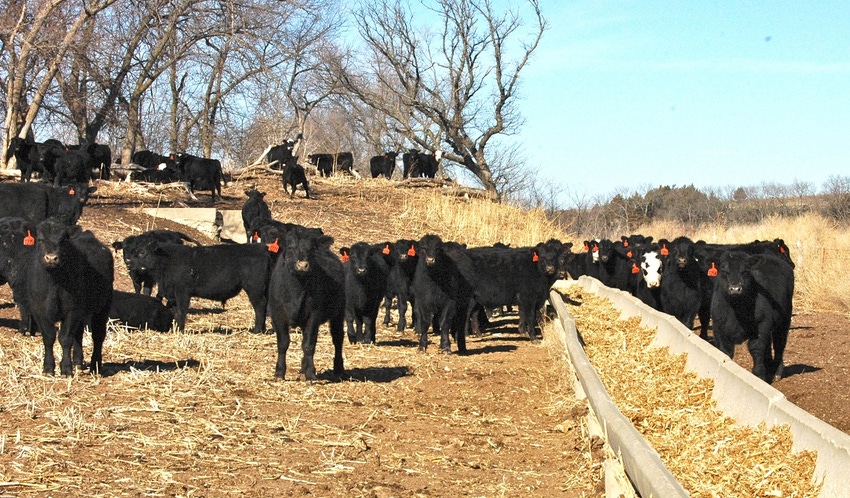March 4, 2019

With huge capital outlays needed to keep a cow-calf or stocker operator in business, ag lenders are extra careful these days when approving a loan.
If you’re a marginal producer who may face added financial challenges, bankers may want to see some type of risk management before handing you a check. Or, if you raise higher-quality calves, it may be wise to establish a floor to protect an expected strong premium price.
With the 2019 cattle market projected to move sideways in price, a ranch with good genetics and a good reputation among potential buyers can likely expect those premiums. But as has often happened, markets can move up or down for any number of reasons. Black swan events like an E. coli scare, a sudden shift in grain prices, or a trade war that goes the wrong way can send markets tumbling.
Price protection should prevent a major loss in an already tight market. At least that's how many bankers view things.
Price protection – through forward contracts, futures or options trading – can insulate prices, says Kevin Wagner, senior vice president at Centera Bank, Satanta, Kansas. "And that’s a good sign to lenders handling your operating loan."
“There’s a huge amount of money at risk in the cattle feeding business,” he says, “and stocker and cow-calf operators also require a lot of capital. For lenders, it often requires different management for higher-graded customers than for marginal producers.”
Wagner adds that a lender may look for more risk management in more-marginal operators with substandard credit.
“Obviously, marginal producers need to keep price control in place, similar to other producers,” he says.
“All of our good producers are using some risk management tools," Wagner says. "Forward contracting is used more widely than futures contracts. You really have to know what you're doing when using futures and options.”
He encourages all producers to carefully consider establishing a price for their cattle based on of their cost of production. “Before you go see your banker for a loan, you have to know your cost of production,” Wagner says.
“When you know your costs, at some point you're going to be presented with a good pricing opportunity where you can lock in a profit. That’s what you need to do. A lot more producers are forward contracting through video sales, as well as through alliances between cow-calf and stocker operators and large feedyards.”

Expect volatility
Kansas State University Livestock Marketing Specialist Glynn Tonsor says producers shouldn’t let down their guard in marketing their calves or feeders: “Considering the price uncertainty we have heading into 2019, if you see a better margin opportunity through forward contracting, consider locking in the full or partial amount to get some kind of reward.."
Tonsor is among those who project that the average cow-calf operation will likely see breakeven prices for 2019.
In early December, his forecasts are for five- to six-weight Southern Plains calves to sell from $171 to $178 per hundredweight in the second quarter of 2019, and to average $169 to $175 for the whole year. He projects seven- to eight-weight steers at $148 to $153 in the second quarter and $148 to $153 for the whole year.
“There’s a lot of room to change with that breakeven projection (given average cow-calf costs of production),” Tonsor says. “There’s uncertainty on the trade front and the demand front. If a producer is worried about downside prices, he should consider forward contracting or possibly using put options as a way to establish a price.”
Option protection, anyone?
Feeder cattle futures and options have long been used to manage risk, but they cost money and you must know what you're doing before pulling the trigger.
Base-level information is this: The CME feeder cattle futures contracts are for 50,000 pounds, which corresponds with about 100 five-weight calves, or 83 six-weight calves. This is the amount of cattle you would be covering with each hedging contract.
Each contract is settled against the CME Feeder Cattle Index covering heavier-weight cattle, which makes it important for calf-marketers to track their own basis. Basis is the difference between cash and futures markets. The www.BeefBasis.com resource is available to assist producers in this endeavor.
Those leery of straight futures hedging may want to consider a simple options strategy to set a price, says Glynn Tonsor, Kansas State University economist. In late November, CME April Feeder Cattle Futures were trading at about $146 hundredweight.
An at-the-money put option cost about $4.60 hundredweight.
A $144 out-of-the-money put cost about $3.70 hundredweight.
A $140 out-of-the-money put was about $2.30 hundredweight.
Such lower-cost put options could be used as insurance against a wreck, or major drop in prices. It all depends on your cost structure, therefore breakeven prices and profit objectives.
An options spread, which uses put and call options together, could be considered to help reduce the cost of setting a floor price.
Here's how that works: For example, in late November 2018 one could have bought the $146 put for about $4.60 and sold a $152 call for about $2.50. That would have set the cost of price protection at about $2.10 ($4.60 minus $2.50).
Tonsor says there would be a market window of between $146 and $152 hundredweight. If the price drops below $146, the floor is protected. If it rises past $152, then the strategy could be lifted and a higher price locked in.
Of course, your basis can vary widely. However, an options strategy can help producers prevent unexpected plunges in the market that would impact both cash and futures prices, Tonsor says.
About the Author(s)
You May Also Like




